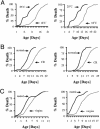An accelerated assay for the identification of lifespan-extending interventions in Drosophila melanogaster
- PMID: 15328413
- PMCID: PMC516504
- DOI: 10.1073/pnas.0403493101
An accelerated assay for the identification of lifespan-extending interventions in Drosophila melanogaster
Abstract
Recent advances in aging research have uncovered genes and genetic pathways that influence lifespan in such diverse organisms as yeast, nematodes, flies, and mice. The discovery of genes and drugs that affect lifespan has been delayed by the absence of a phenotype other than survivorship, which depends on the measurement of age at death of individuals in a population. The use of survivorship to identify genetic and pharmacological interventions that prolong life is time-consuming and requires a large number of homogeneous animals. Here, we report the development of an assay in Drosophila melanogaster using the expression of molecular biomarkers that accelerates the ability to evaluate potential lifespan-altering interventions. Coupling the expression of an age-dependent molecular biomarker to a lethal toxin reduces the time needed to perform lifespan studies by 80%. The assay recapitulates the effect of the three best known environmental life-span-extending interventions in the fly: ambient temperature, reproductive status, and calorie reduction. Single gene mutations known to extend lifespan in the fly such as Indy and rpd3 also extend lifespan in this assay. We used this assay as a screen to identify drugs that extend lifespan in flies. Lipoic acid and resveratrol were identified as being beneficial in our assay and shown to extend lifespan under normal laboratory conditions. We propose that this assay can be used to screen pharmacological as well as genetic interventions more rapidly for positive effects on lifespan.
Copyright 2004 The National Academy of Sciencs of the USA
Figures





References
-
- Masoro, E. J. (2003) Sci. Aging Knowledge Environ. 8, RE2. - PubMed
-
- Helfand, S. L. & Rogina, B. (2003) Adv. Genet. 49, 67–109. - PubMed
-
- Guarente, L. & Kenyon, C. (2000) Nature 408, 255–262. - PubMed
-
- Kirkwood, T. B. & Austad, S. N. (2000) Nature 408, 233–238. - PubMed
-
- Rogina, B., Reenan, R. A., Nilsen, S. P. & Helfand, S. L. (2000) Science 290, 2137–2140. - PubMed
Publication types
MeSH terms
Substances
Grants and funding
LinkOut - more resources
Full Text Sources
Other Literature Sources
Medical
Molecular Biology Databases

